Chapter 8
Shooting Events
The biggest issue surrounding event photography in general is the lack of control. The event—whether it’s a softball game or a wedding—has a momentum and a life of its own. You have to be ready, because there are no reshoots or “do-overs.” You need to anticipate and predict the future but also stay alert and react to the present.
I’ve been stressing the basics throughout this book because it’s important to be vigilant when you do use your camera automatically. Shooting events is the time to harness all of the automatic features your camera has to offer. If you have been practicing, then you will know when it’s making stupid decisions and how to quickly override them.
Weddings
I’m going to assume that you (or someone else) have hired a professional to do the major photography at a wedding. If you are even considering shooting a friend or family member’s wedding as the sole photographer, without a professional photographer in attendance, you are just plain nuts.
I seldom shoot weddings. The few that I’ve shot have been the most physically demanding, nerve wracking assignments in my career. Weddings are very hard, and I have the utmost respect for my friends and colleagues who shoot them every week. Weddings demand everything—every ounce of skill, resourcefulness, and stamina that a photographer has. Wedding photographers have a big job to do. Stay out of their way, and give them the respect that they deserve.
Your Role at a Wedding
It is fun to shoot a friend’s wedding. Once your friends and family realize your interest in photography, it’s inevitable that you will be invited to a wedding … “and we hope you’ll bring your camera.”
This can be a tricky line to walk. The first priority is to be a gracious guest. The second is to stay out of the way of the professional photographer. The third is that your pride will require you to make at least one great photo that no one else will get.
If you are a member of the bridal party, this is easy and your role is nicely defined. You have a “backstage pass” to photograph during the moments that the pro isn’t around—when the bride or groom are getting dressed or during the rehearsal dinner. Look for significant details, like floral arrangements, or shoot candids of wedding party members who are waiting for their turns in the formal portraits. Don’t try to shoot the entire event; concentrate on one particular aspect.
Try to shoot candids from a different angle from the pro. If you are jockeying for the same position, you are just hindering the professional and covering something that he or she already has. I use this rule of thumb for all event photography, including major news stories. When I see a gaggle of lenses pointing in one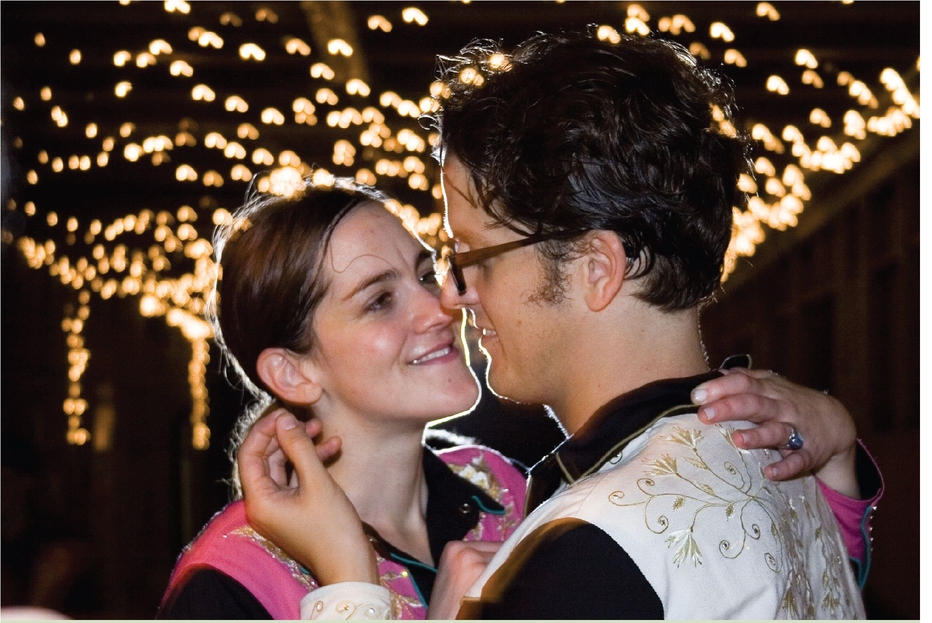
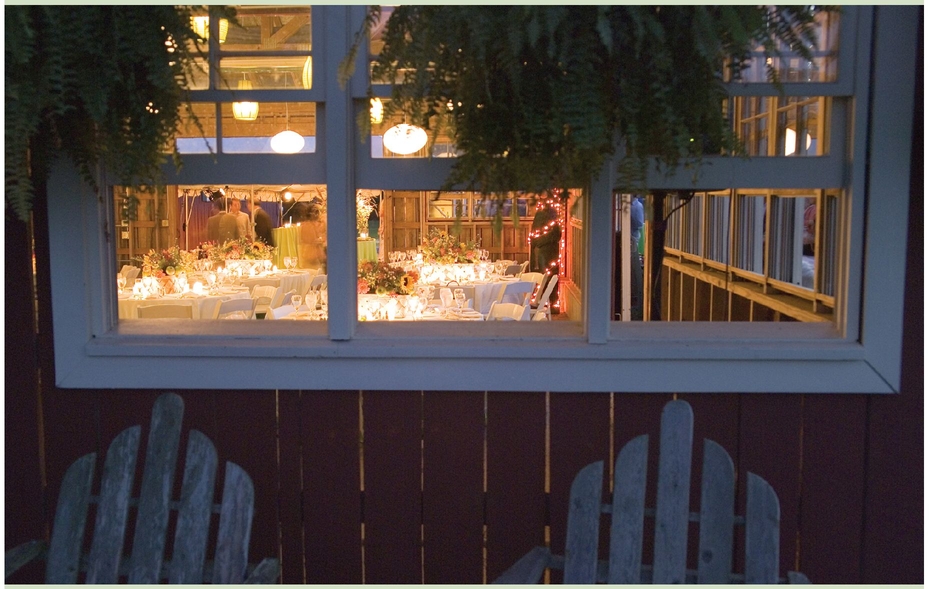 direction, I try to stay away from the pack. It’s an indication that the angle is obvious and formulaic—not necessarily that it’s good. Our job is to see what no one else is seeing and put a unique spin on the it.
direction, I try to stay away from the pack. It’s an indication that the angle is obvious and formulaic—not necessarily that it’s good. Our job is to see what no one else is seeing and put a unique spin on the it.

The rim of backlight is from a wireless remote flash that I got another guest to hold.

This wedding was in Nashville, Tennessee, and the groom was a musician. The rehearsal dinner was a country-themed barn dance.
The time when the amateur photographer can really shine is at the end of the reception. This is when the pro is tired and might even be packing up but the party is getting wild. Have fun and play.

Look for candids and details like this while the pro is shooting formal photographs.
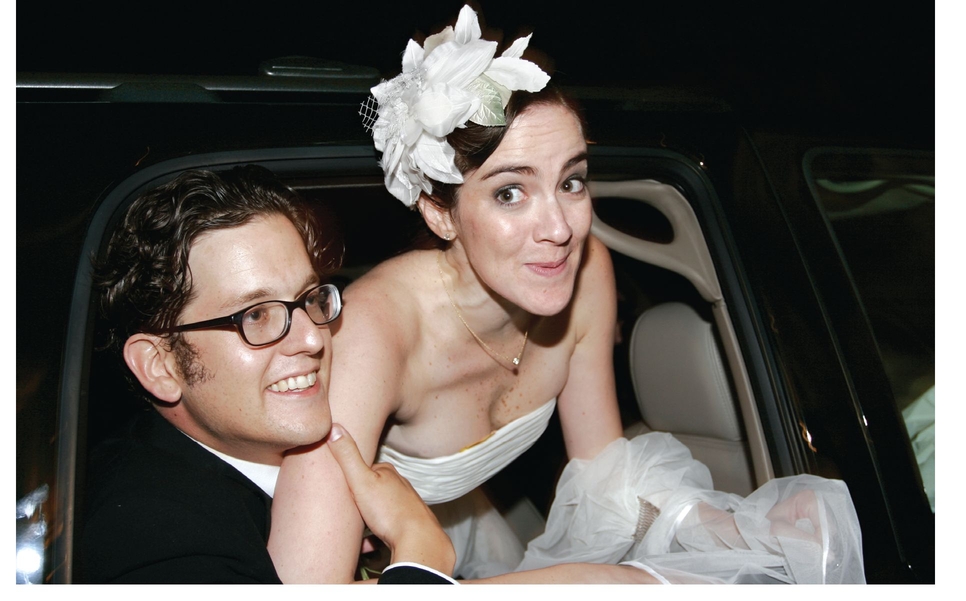

Retain as much of the available light as you possibly can.
Pro Tip
RedEye happens when the subject’s eyes are dilated (like at a dark wedding reception) because the flash illuminates the blood vessels in the back of the eye. This is one of the reasons why wedding photographers use flash brackets to lift the flash high above the lens. The slight change in height makes the light more flattering and changes the angle of the flash, eliminating red eyes.
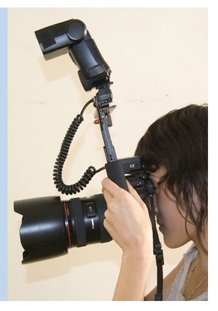
Scouting the Location
For pros, location scouting is a science. We often use a compass or special software to predict where the sun will be and plan the shooting schedule accordingly. We might shoot tests for the lighting or plan for weather contingencies. Is there a sheltered area in case it rains? Is there a bathroom nearby to touch up makeup?
The same is true for your shots: What’s the existing light like? What’s the policy of the pastor/rabbi where you are allowed to shoot? Can you use flash? (Probably not.) Is there a place to stash your equipment?
Try to arrive a little early and take a quick look around for creative possibilities. You might be able to grab the bride for a few minutes if you have a particular location already in mind, but she’ll be angry if you take her away from the reception and wander around without a plan. Scouting and looking carefully at your surroundings will help you set your camera in advance and be ready for opportunities.
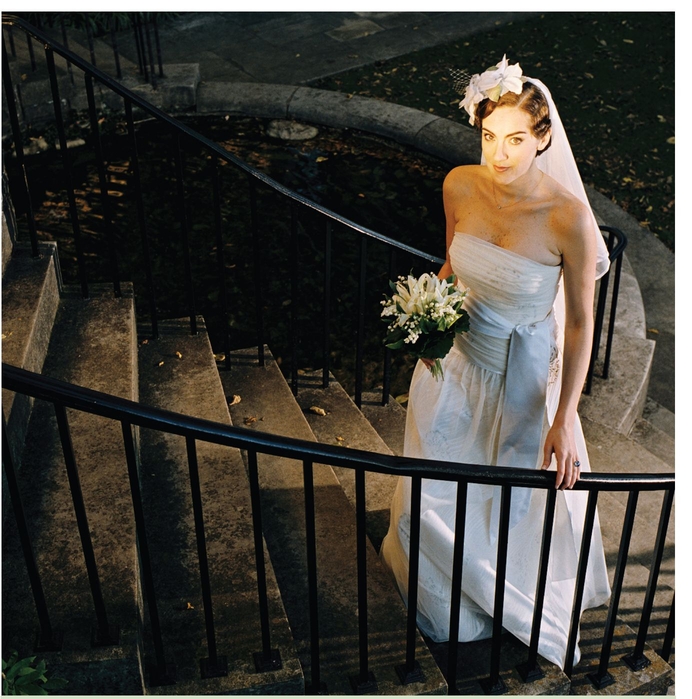
It’s busy day for the bride. If you are going to try and do something formal, then have a plan in place and let her beg off if she seems reluctant.
Pro Tip
If you are curious about trying RAW files, a wedding is the perfect opportunity. Weddings are contrasty events (white dresses and big dark rooms). You might want to try shooting JPEG and RAW formats for more exposure latitude and contrast control.
Technique
You have to be ready—but you are also a guest, and you want to enjoy yourself. Here’s a simple “cheat” to have your camera set up and available all the time.
If you are indoors, set your camera to Aperture Priority mode. Crank your ISO up until your camera is getting an adequate (or slightly underexposed) exposure in the range of about 1⁄20th to 1⁄60th of a second at about f/4 (an ISO of 400 should work for most rooms; you might need 800 if you are using a kit zoom). Leave your white balance set to Auto.
This setting will ensure that you are including some of the available light in every shot and keeping the background from going completely dark. The background (ambient light) will go yellow but will probably look nice.
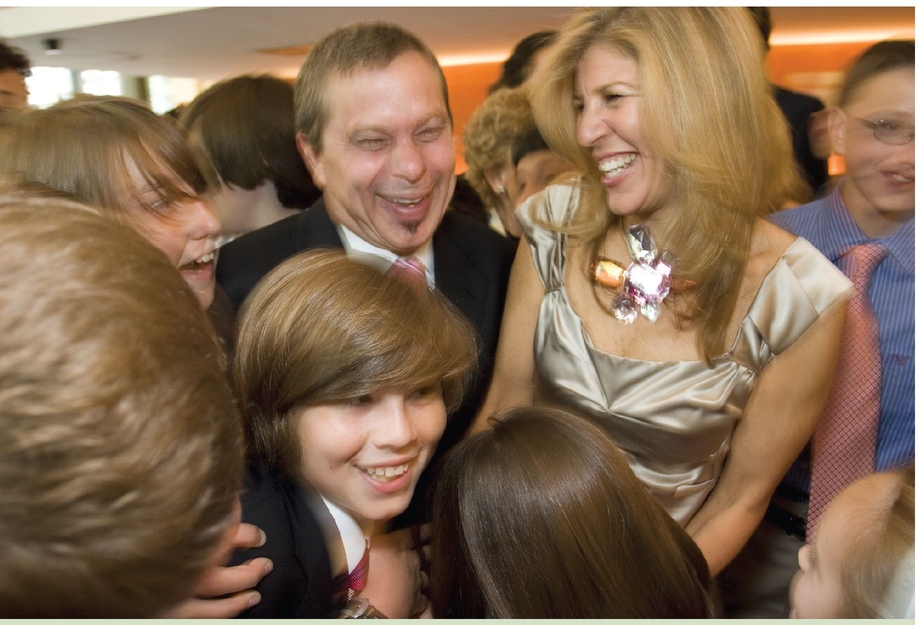
Events are about energy. Get in tight and accept some flaws.
You might get some camera motion from the slow shutter speed, but remember that the flash duration is only about 1⁄1000th of a second or less. The foreground, where the couple is, should be quite sharp. If the background has some camera movement, it can often look beautiful.
Photosensitive
If you’re set up for an indoor event and you move outdoors, the camera will have to be set a much higher shutter speed and might exceed the maximum flash sync speed that your shutter is capable of.
Now, set the exposure compensation for your flash to underexpose by one stop. Shoot a couple of test photos of another guest at about five to eight feet away to confirm the settings. You might need to adjust the flash compensation a little to suit your tastes.
If the photo includes too much ambient light, then switch the camera to Manual mode and set your shutter speed to underexpose by one stop. You want the foreground to be bright but not overexposed and the background to be slightly underexposed but not black (like the photo of the woman in Chapter 6 where the background was underexposed).
Now you can enjoy the party and still be fairly certain that your camera is ready for almost anything.
Bar and Bat Mitzvahs
Everything I said about weddings also applies to bar and bat mitzvahs with one big exception: bar/bat mitzvahs are really fun to shoot. They are raucous, great parties, and have very little pressure.
The family has probably hired a pro to shoot the ceremony and formal portraits. Just stand aside and be a guest. Like a wedding, the ceremony is solemn—and too many cameras are a distraction.
During the party, shoot what the pro isn’t shooting. When the family is lifted on chairs for the Hora, shoot the reactions of the crowd. If you are one of the family members who is going up high in a chair, then make sure you have a point-and-shoot camera in your pocket so that you can shoot from your unique, first-person point of view.
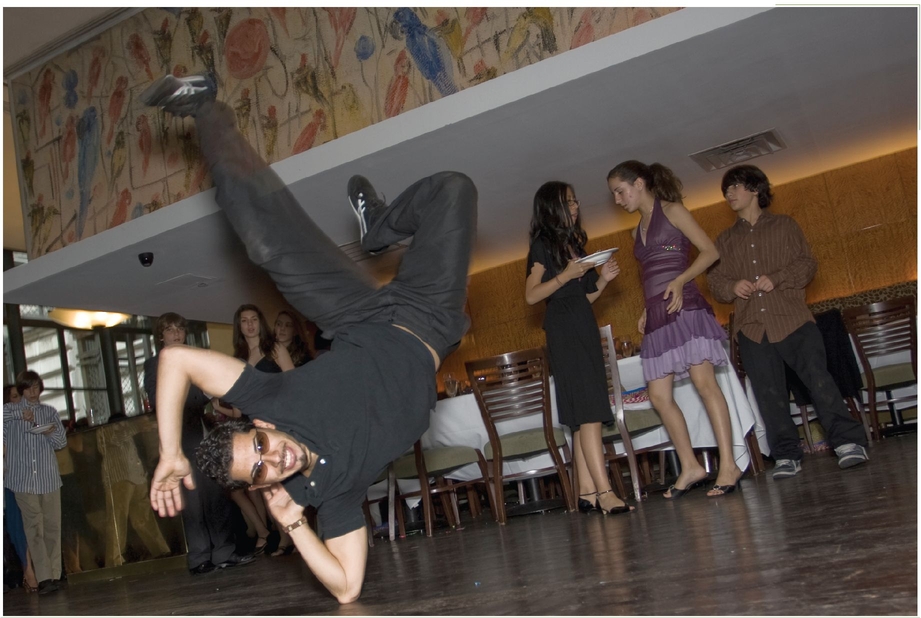
Bar and bat mitzvahs often have DJs and dancers to keep the party going, and they can be great allies for photographs.
Sports
I love shooting sports, but I would be lost at a baseball game, and I can barely comprehend basketball. Hockey looks like a ballet with sticks and fighting to me. Nonetheless, all sports and athletes have a grace and beauty that is always a joy to watch, and all sports photography (at any level) represents a distinct challenge to any photographer.
Pro Tip
Events are about moments more than techniques. If you sense that you are missing significant moments because you are confused by techniques, just switch to Program mode. That’s what it’s there for.
I think the best part of shooting sports professionally is the athleticism that goes in the photography itself. When I’m on assignment I watch the event unfold and find my feet moving of their own accord in anticipation of the future, my eyes locked on the action. The next thing I know I am sprinting along with a 300mm lens trying to find the perfect intersect in time and space with the event itself. At this point you are no longer an observer, you are a new participant in the event, another dancer on the stage.
Outdoors
The first question to answer here is what level of sporting event you are shooting. If it’s a Formula One race or a Major League game, then you had better bring the longest zoom lens you have (or can rent) and are willing to carry. Access is extremely restricted, and you won’t be allowed to wander around.
Shooting family sports like little league or high school basketball games is a different story—and another situation where your camera does very well on one of the full program settings.
Outdoor sports are pretty easy. There’s lots of light, so you can buy a very affordable (and slow) zoom lens with a variable aperture (like an f/4-f/5.6). Image stabilization is a definite advantage but not completely necessary. Lenses like these are available in the $300-$400 range even if you buy a big-name original equipment lens (like a Canon or Nikon). I’d happily take a lens like this on a professional assignment if I had to travel light. I doubt that I’d see a big-quality difference between these lenses and an expensive pro lens under well-lit conditions.
Photosensitive
Try not to completely fill your CF or SD card. Some cameras will continue to shoot although there isn’t enough free space on the card. If there’s only enough space on the card for two more images and you shoot a fast sequence of six, the remaining photos will get “buffered” to the camera’s internal memory and have no place to go. The camera will probably freeze until you pull the card. Sometimes this can corrupt a card, and you may lose many more than just the few photos in the buffer memory. Change cards before you completely fill them.
I only shoot RAW files, and my personal cameras won’t shoot RAW on the program Sports setting, so I have little experience with shooting in this mode. However, it seems to be awfully good; in fact, it seems tough to beat. In my experiments, both the Nikon and my Canons always picked a shutter speed and f-stop on their own that I thought was a pretty smart choice for most sports situations. They also both automatically change the autofocus mode from “one shot” (which locks the camera up if the focus isn’t perfect) to “servo” or “dynamic” autofocus (which allows the shutter to fire even if the focus isn’t perfect). And that’s what I would have recommended (depth of field often makes up for the slight miss in critical focus).
Sports photos are also an area where the JPEG format works very well. Most prosumer DSLR cameras are a little slow, especially when shooting RAW files. This is because RAW files are large and take more time to write to the digital media. Shooting JPEGs speeds most cameras up considerably. If you want to capture the entire sequence of Junior hitting the ball, running, and sliding into first, then shooting JPEGs is the way to go.
Indoor Sports
Indoor sports are a quite a bit harder. There’s less light, so you’ll have to crank up the ISO and/or shoot with a faster (more expensive) lens. This a good time to consider a fixed focal-length, large-aperture lens like an 85 mm f/1.8, or a 50mm f/1.8 as the digital equivalent (either are much more affordable than a comparable fast zoom). That should get you close enough in a high school gym. You will also have far less depth of field.
Remember that an image-stabilized lens only helps you handhold a camera at lower shutter speeds. Stopping the motion of an athlete can only be accomplished by a higher shutter speed and/or faster lens/ISO combination. Stabilization is nice, but it’s not a substitute for real speed. Shooting with flash is not a great option because you will probably be too far away for it to be effective.
The bigger problem will be white balance—especially if you shoot in a lot of different gyms or arenas (if you are following your daughter’s gymnastics career, for example). This is a time when a small investment in an Expoimaging disc makes a lot of sense because you can just create white balance as soon as you walk into the gymnasium. If it’s an occasional problem, just use the white piece of paper solution I outlined in Chapter 6. Gymnasium lights are invariably lit with some form of mercury vapor, and if you are shooting JPEGs a custom white balance is really necessary under these conditions.
If you absolutely have to use flash for an indoor sporting event, remember that your flash can’t light an entire gymnasium—and it takes time to recycle. Time your shots precisely because you will only get one chance; prefocus on the place the action will happen and wait for the moment. Your pop-up flash is woefully inadequate for indoor sports. You might want to buy a separate shoe-mounted flash if your son just made the varsity basketball team.
One thing to note is that I think cameras will be capable of much higher ISOs with far less digital noise in the very near future—possibly by the time you are reading this book. The typical resolution for amateur cameras will probably stay in the 6 to 10 megapixel range, but noise reduction technology from professional cameras like Canon’s EOS-1D Mark III will trickle down to consumer-level cameras and make shooting in marginal light conditions easier than ever very soon.
Hidden Knowledge
I don’t really shoot much in the way of stick and ball sports for a very good reason. I was terrible at them, and I don’t know how to watch them. I can watch a skier and know exactly when he or she lost a race by 1⁄100th of a second or exactly when and where a particular motorcycle racer is going to crash. When I watch a football game, however, I haven’t got a clue.
The top sports photographers are students of the particular game they shoot. They know when to relax and when their finger has to be on the button. They are masters at predicting the future and seeing where the play will happen. The key to being good at shooting sports has much more to do with being knowledgeable about the game rather than equipment.
Case Study: Sports Photography
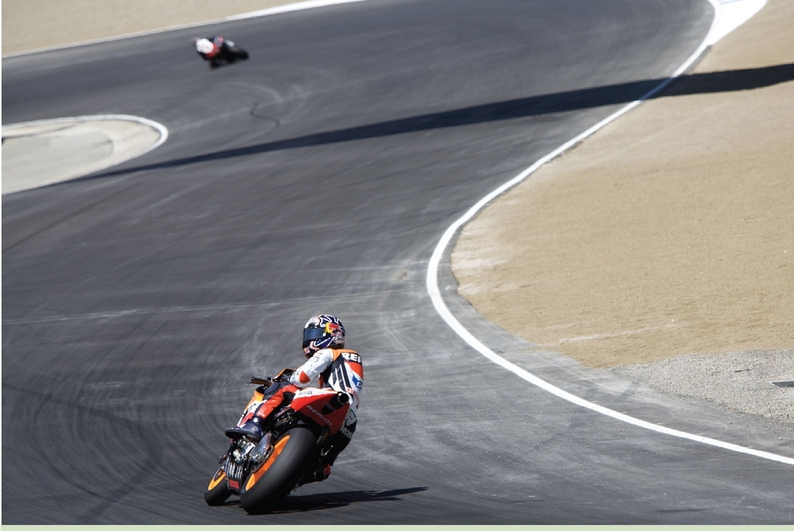
A few years ago, I wrote a story about one of my favorite athletes, MotoGP star Nicky Hayden. This is Nicky during a practice run checking to make sure another racer isn’t following him.
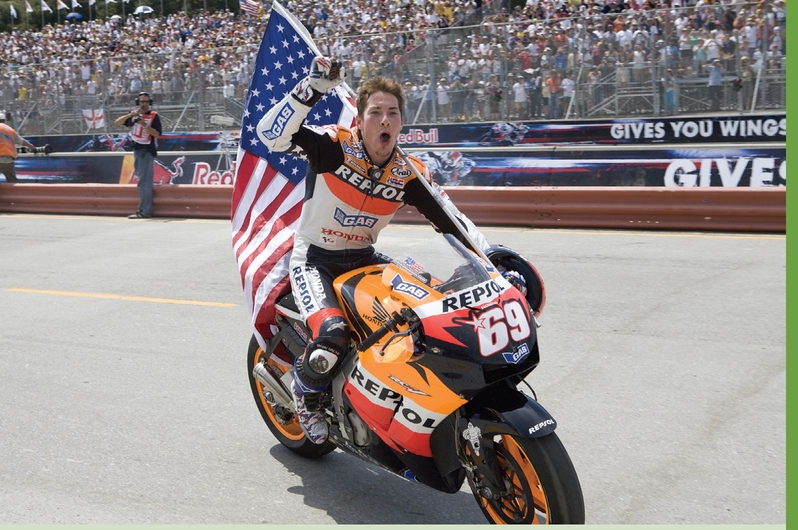
When Nicky won the race, I wanted to be sure I was in his pit for the victory celebration—so I positioned myself and awaited his arrival, only to watch him do a massive smoky burnout a quarter of a mile away on the front straight for the fans. I was sure I had missed a pivotal shot (all the other photographers were there). I took a chance and held my ground. When Nicky pulled into the pits, I was the only photographer there to get this moment.
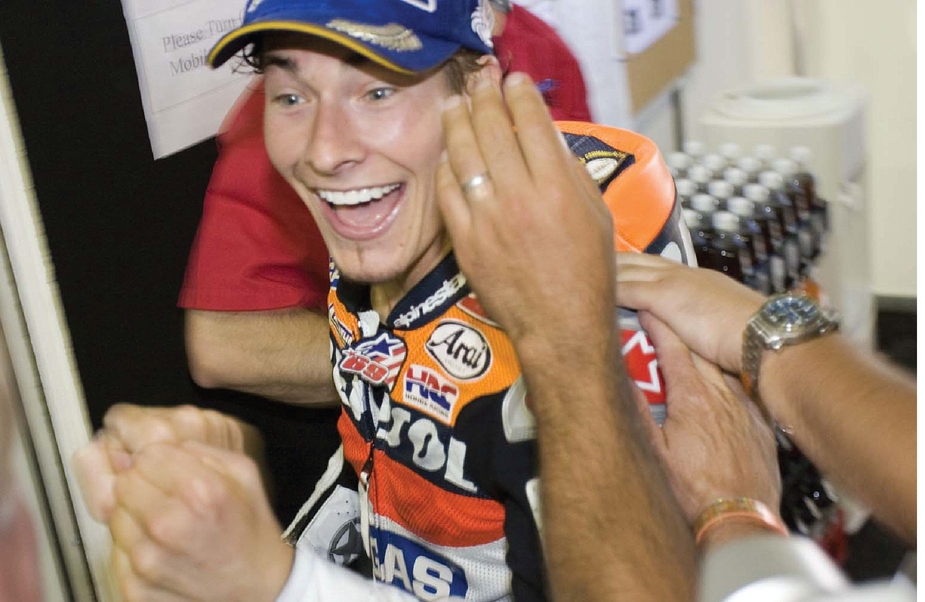
I ran like a track star for the press conference because I knew the next great shot would be when he walked in—and I wanted to stake out the best spot right next to the door.
Recitals and Performances
In today’s visual culture, a simple kindergarten graduation can resemble the photographer’s pit at a White House press conference—bristling with lenses, flash, and video screens. Your big problem at the grammar school holiday pageant might be the competition from the uber soccer mom who will deck you if you block her shot.
Dance recitals and school plays are pretty easy to shoot only because the possibilities are so limited. Crank the ISO up so that you can shoot with available light, and set the white balance to tungsten to eliminate most of the color cast from the stage lights. The average kit lens is pretty useless under these conditions (too slow and not long enough). You could rent or buy a long lens, but in these situations I’d completely avoid the traditional approach.
I’d make it a story …
Thinking Cinematically and Editorially
The one great thing all events have in common is that they are complete stories. They have a cast of characters and a beginning, middle, and end. A photo of your daughter as a tiny dot on a dark stage has little interest to anyone but you and her, but a portrait (shot before or after the recital) in her ballet outfit or at the piano keyboard offers some better visual possibilities and is more likely to have some enduring value.
Magazine photographers and photojournalists can’t just take one photograph; they have to flesh out complete stories. Even when you only see one photo, it’s a sure bet that the photographer shot a few hundred. They have to supply the editor with a range of options and possibilities that will get narrowed down to the best 5 to 10 photos. Some of the photos will run as large, double-page spreads; others will run small and may only serve to supply information or background ambiance. You don’t know what’s going to be important until later, so you shoot everything and try to make it all as good as you can.
Thinking like this can help you a lot. It keeps you interested and engaged in making photographs through the entire event (and might make the event more fun for you, as well). It makes the moments when your daughter arrives at the auditorium, puts on her slippers, and takes a bow just as important as her grand jetée. The good photograph is usually somewhere in the details, not in the obvious. I’d also remember to photograph your child’s friends and the teacher/coach as well. They might not seem important to you, but they probably are to your child.
Not all of the photographs you make will be good, but neither are all of the photographs that pros make. They take chances and are willing to strike out all the time; these are the photos you never see. Editing it down to the four or five home runs is what makes us look so good.
Event FAQs
The bride is coming down the aisle and my camera has completely shut down! What do I do?
This is why pros always have multiple cameras. First, slow down and don’t panic. Was the camera on? If it was then check and make sure the card isn’t full. If the card isn’t full then take the battery out and replace it. Even if the battery is still charged, simply taking the battery out and putting it back in will often “reboot” the camera and fix the problem.
Did you just finish shooting a long sequence close to the capacity of the card? Is the camera displaying an “error” message? If this is the case the camera is probably locked up because the buffer has no place to send the images you just shot (you’ll probably see a blinking light on the camera indicating that the camera is trying to “write” the images. The only solution is to pull the card and sacrifice the images in the buffer (and possibly more).
Finally, check the lens mount. If the lens isn’t locked in then the camera won’t fire.
The important thing is to behave as if there’s no pressure. If the same thing happened in your living room while you were shooting a still life you might be puzzled, but you wouldn’t panic. You would look at the problem methodically and carefully. It’s exactly the same here.
The buffer is the cameras internal memory. It has enough memory to hold a given number of images (depending on size and file format) until it fills and the camera will no longer fire. As the data (images) are being copied onto the CF or SD card the buffer will continue to accept more exposures. Professional cameras have very large buffers, some can hold over thirty 10MP RAW files. Most amateur cameras sacrifice large buffer space for other features and an affordable price point.
My flash is completely over/underexposing every shot! What do I do?
If it’s the pop up flash, and it’s a high pressure moment then I’d just switch to “Program.” As much as I stressed manual operation in the beginning of this book it’s important to remember that the "P” setting is your life preserver. Don’t be afraid to use it when you need it.
If you are already on “Program,” then check the flash exposure compensation mode. You might have switched the setting for an earlier shot and forgotten to set it back.
If it’s an auxiliary flash unit, then check to make sure it’s set to “TTL” for through the lens metering. If it is set correctly then check to make sure it is fully on the camera. Sometimes they can slide back on the hotshoe and still fire but not connect to the TTL metering.
My flash unit is firing intermittently, what do I do?
Chances are it’s time to change batteries because the flash isn’t fully recycling in time.
Planning Ahead
Every time you pack your camera bag, you are predicting the future. (Even if you don’t pack a bag, you are predicting the future.) and even when you just throw a camera over your shoulder and think, “This is all I need; I’m covered,” you have made a prediction.
It might seem obvious, but take a few minutes a couple of days before a big event to close your eyes and imagine how the event will play out. Predict the future. Ask yourself, “What photographs do I want or hope to get?”
I do this before every shoot, and it’s amazing how often I realize that I have forgotten to pack or rent some useful item. It might be a long lens, a remote control, or just charging a spare battery—but there’s always something.
Rent or Borrow Extra Equipment
Buying a 300 mm f/2.8 lens to shoot Junior pitching in the state finals is probably prohibitive. But it is a big event in his life, and you probably want to shoot it as well as you know how.
Pros can’t afford to own every camera, light, or lens there is. Most of us have a basic package that covers 90 percent of our regular assignments, and we rent gear when we have something out of the ordinary. If you live in a major city, then chances are there is a camera store near you that rents equipment. Renting is also a great way to try before you buy, and it’s often very reasonable.
I also recommend to my former students who are starting out as pros that they “buddy up” with friends and make sure that they buy compatible equipment so they can borrow from each other. By nature, events are special occasions and might require special equipment.
What to Bring
When shooting events, you should bring along at a minimum (we’ll call this level 1, for event scenarios):
• Extra batteries
• Spare film or digital media cards
To take it one step farther, you should have (level 2):
• A tripod
• A shoe-mounted, on-camera flash with a light modifier (small soft box or bounce diffuser)
And, to really go all out, bring along (level 3):
• A fast, long lens like a 70-200 mm f/2.8 zoom or an 85 mm f/1.2-2
• And/or a fast, wide-angle lens in the 20-28 mm f/1.4-2.0 range
Personally, I find the fast, wide-angle lens to be indispensable.
Last but not least, these are all great for weddings (level 4):
• A flip bracket to hold a shoe-mounted flash
• A second wireless flash unit
• An auxiliary battery pack for the flash
Events are a challenge to your skills as a photographer, and this is precisely why they are so much fun. When you strive to impress, (even if it’s just for your family, friends, or yourself) you raise the level of your game for all of your photography.
The Least You Need to Know
• Stay out of the way of the pro at weddings, and go for the shots that the pro won’t be taking.
• Think ahead when you shoot events; otherwise, you will always be too late for key moments.
• Use Program mode freely.
• Strive to tell a story with your event photos, and be prepared with an equipment checklist.
..................Content has been hidden....................
You can't read the all page of ebook, please click here login for view all page.
